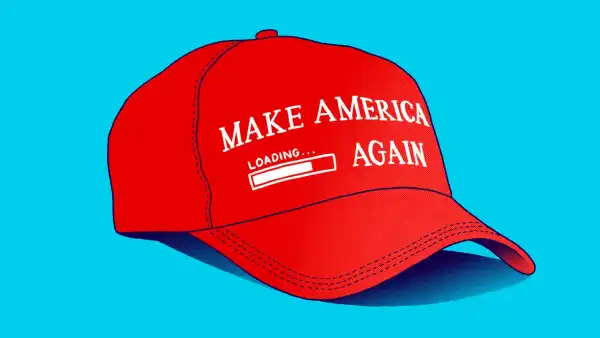
Save this storySave this storySave this storySave this story
Not long ago, on a Times podcast, Paul Krugman breezily announced (and if we can’t trust Paul Krugman in a breezy mood, whom can we trust?) that, though it’s hard to summarize the economic consequences of the pandemic with certainty, one sure thing is that it killed off ties. He meant not the strong social ties beloved of psychologists, nor the weak ties beloved of sociologists, nor even the railroad ties that once unified a nation. No, he meant, simply, neckties—the long, colored bands of fabric that men once tied around their collars before going to work or out to dinner or, really, to any kind of semi-formal occasion. Zoom meetings and remote work had sealed their fate, and Krugman gave no assurance that they would ever come back.
Actual facts—and that near-relation of actual facts, widely distributed images—seem to confirm this view. Between 1995 and 2008, necktie sales plummeted from more than a billion dollars to less than seven hundred million, and, if a fashion historian on NPR is to be believed (and if you can’t believe NPR . . . ), ties are now “reserved for the most formal events—for weddings, for graduations, job interviews.” Post-pandemic, there is no sign of a necktie recovery: a now famous photograph from the 2022 G-7 summit shows the group’s leaders, seven men, all in open collars, making them look weirdly ready for a slightly senescent remake of “The Hangover.” As surely as the famous, supposedly hatless Inauguration of John F. Kennedy was said to have been the end of the hat, and Clark Gable’s bare chest in “It Happened One Night” was said to have been the end of the undershirt, the pandemic has been the end of the necktie.
Such truths are always at best half-truths. Sudden appearances and disappearances tend to reflect deeper trends, and, when something ends abruptly, it often means it was already ending, slowly. (Even the dinosaurs, a current line of thinking now runs, were extinguished by that asteroid only after having been diminished for millennia by volcanoes.) In “Hatless Jack,” a fine and entertaining book published several years ago, the Chicago newspaperman Neil Steinberg demonstrated that the tale of Kennedy’s killing off the hat was wildly overstated. The hat had been on its way out for a while, and Jack’s hatless Inauguration wasn’t, in any case, actually hatless: he wore a top hat on his way to the ceremony but removed it before making his remarks. Doubtless the same was true of the undershirt that Gable didn’t have on. They were already starting to feel like encumbrances, which might explain why Gable didn’t wear one. And so with the necktie. Already diminishing in ubiquity by the Obama years, it needed only a single strong push to fall into the abyss.
Fashion seems particularly susceptible to such fables of origin and dissolution, though some of them turn out to be true: Babe Paley, in a rush, in legend, does seem to have knotted her Hermès scarf around her handbag, and, voilà, every other woman at, or wanting to be at, La Côte Basque soon did the same. Similarly, the necktie began its journey to dominance in seventeenth-century France, when the recruitment of Croatian soldiers, whose uniform included a distinctive knotted scarf, sparked a new trend at the court of Louis XIV. (The term “la cravate” comes from “Croat.”) For the next couple of centuries, the space around men’s throats was host to a bewildering array of cravats, stocks, scarves, kerchiefs, solitaires, jabots, and the style that eventually came to be called the ascot. What we now think of as the necktie—cut on the bias, made of three or four pieces of fabric, and faced with a lining—was actually a fairly recent, and local, invention, that of a New York schmatte tradesman named Jesse Langsdorf. What we call “ties” generically are, specifically, Langsdorf ties.
The Langsdorf necktie that emerged early in the twentieth century was, to be sure, hideously uncomfortable. (It is no accident that a necktie party was a grotesque nickname for a hanging.) Their constriction made them perhaps the masculine counterpart of the yet more uncomfortable fashion regime—high heels—forced upon women. On occasion, of course, a woman might wear a tie, too, as a daring appropriation of fixed ideas of masculinity. Marlene Dietrich was photographed regularly, in the thirties, in tailored men’s suits and club ties (one particularly splendid wide polka dot stands out), but this seemed an expression not so much of what we now call gender fluidity but of perfect gender switching—a passage from one neat cubbyhole to the next.
For all the necktie’s absurdity, it deserves a moment of mourning. It was the last remaining bit of plumage in male attire and an important vestige of dandyism—an aesthetic that, contrary to what people think, was anything but gaudy. Though Beau Brummell’s name has become oddly synonymous with masculine display, in truth he was intent on curbing the overelaborate fopperies of the eighteenth century. Insisting on elegance without ornament, a perfection of line achieved through attention to tailoring and fit, he ushered in the reign of gray which still determines much of men’s formal wear. The one flourish permitted in Brummell’s frock-coat ensemble was the cravat, perfectly tied. (A visitor once encountered Brummell’s valet emerging from his rooms carrying a tray of crumpled cravats and explaining, “These, Sir, are our failures!”) Similarly, the most famously fashionable man I have ever known wore only gray double-breasted suits to any even remotely formal occasion—which included opening nights at the theatre—and regarded even a black suit as a faux pas. (“It’s what a waiter wears.”) But he luxuriated in polka-dot silk ties from Sulka and Charvet, billowing and gleaming.
The art historian Kenneth Clark writes in his autobiography of how, in the nineteen-thirties, when he was the director of the National Gallery in London, he endured a staff rebellion that almost unseated him from the office. When an insurgent colleague was asked for instances of what he had done wrong, “the only concrete fact that my colleague could think of was that he objected to my neckties.” Clark, to his credit, recognized the rationality of this objection. “Neckties, albeit to a lesser degree than hats, are symbolic and almost the last things that link us to the display rituals of birds. . . . So my frustrated colleague’s answer was quite justifiable by Warburgian standards.”
By “Warburgian standards,” Clark meant the standards on symbolism created by the great, mad art historian Aby Warburg. Warburg wrought a revolution in the study of visual communication, high and low alike, by insisting that symbols are the beating heart of style. The meaningful attributes of a visual display—the gown on a Renaissance nymph or the necktie on a middle-aged man—had been handed down by mysterious but durable traditions that filled permanent human needs. We all “stand on middle ground between magic and logos, and their instrument of orientation is the symbol,” Warburg wrote. One sees at a glance the utter applicability of this formula to the necktie: The logic of the suit is balanced against the magic of the tie. The two together become symbolic: the gray or blue jacket reminds us of a common class background; the distinctive pattern of the tie orients us toward the wearer’s unique identity.
That identity can be individual but also communal, as with the club tie, a genre that proliferated much of the twentieth century to denote membership of clubs, schools, universities, regiments, sports teams, Masonic lodges, choral societies—the list is endless. It registered as what might be called a stealth uniform. Emblazoned with emblems of the club or, more often, just its colors in diagonal stripes, such a tie was a kind of code that spoke only to those in possession of it. To others, the pattern of stripes would seem merely a pattern of stripes. Yet, over the years, the club tie, in best Warburgian fashion, set itself free from denoting a particular organization. If you ask for a club tie in most menswear stores you won’t be asked which club; you’ll be shown a rack of ties whose stripes and faded colors have come to connote the idea of clubbiness, the concept of élite belonging.
Examine any now unused collection of ties, and you will find that they are full of tightly compressed meanings—once instantly significant to the spectator of the time and still occultly visible now. Not only the specific meanings of club membership but also the broader semiotics of style. In any vintage closet, there are likely to be knitted neckties that still reside within the eighties style of “American Gigolo”—which, believe it or not, helped bring Armani to America. The knit tie meant Italy, sports cars, daring, and a slight edge of the criminal. There are probably ties from Liberty of London—beautiful, flowered-print ties whose aesthetic ultimately derives from the Arts and Crafts movement, with its insistence on making the surfaces of modern life as intricate and complexly ornamental as a medieval tapestry or Pre-Raphaelite painting. If the closet is old enough, its ties will show a whole social history of the pallid fifties turning into the ambivalent sixties turning into the florid seventies. The New Yorker cartoonist Charles Saxon captured these transitions as they occurred, in a career that can be seen as a dazzling study of ties and their meanings. The neatly knotted ties of Cheeveresque commuters give way in the early seventies to the ever-broadening ties of advertising men, flags they waved to show off their desire to simultaneously woo the counterculture and keep out of it.
The tie could sometimes get so compressed in its significance as to lose its witty, stealthy character and become overly and unambiguously “loaded.” There is no better story of suicide-by-semiotics than that of the rise and death of the bow tie, which, beginning in the nineteen-eighties, became so single-mindedly knotted up with neoconservatism, in the estimable hands of George Will, that to wear one was to declare oneself a youngish fogy, a reader of the National Review, and a skeptic of big government. The wider shores of bow-tie-dom—the dashing, jaunty, self-mocking P. G. Wodehouse side of them—receded, and were lost. It became impossible to wear a bow tie and vote Democratic.
Fortunately, there is still one redoubt of the necktie in Manhattan. It is the tiny store called Seigo on upper Madison Avenue, where Seigo Katsuragawa presides in impeccable elegance over the last remaining harvest of perfect handmade silk ties: club ties, Liberty ties, plus cummerbunds and ascots and all the secondary paraphernalia of the lost kingdom of the decorated neck. Katsuragawa presents his wares in neat, folded array, a bandbox of small ribbons of fictive identity. (He has perhaps the best taste of any retailer on Madison Avenue—exquisitely curated jazz, particularly the music of Bill Evans and Cannonball Adderley, plays in the background of his store throughout the day.) He explains to a visitor, in a cautious, rhythmically halting English, still heavily accented after a half century in America, that the existence of the store and its beautiful handiwork depend—with an irony one could not invent—on the previous disappearance of another legendary garment, the kimono.
“Fewer and fewer kimonos being worn in Japan!” he explains. “This means that the silk manufacturers had less and less customers.” The silk mills of Kyoto, in business for centuries making kimonos, were eager for a new market. Seigo, as he prefers to be called, began to design ties and purchase silks. All of his ties are woven in Kyoto and then hand-sewn in a mill outside Tokyo. He produces them in limited editions, usually eight per color at a time.
For years, Seigo’s work was essentially wholesale, with him as the middleman between the Japanese silk-makers and big stores: Nordstrom, Paul Stuart, and the like. But the tie market shrank and shrivelled, until now it is enough only for the environs of his tiny store. Occasionally, a club will demand a new club tie—the Union Club has their ties made by him—and, he admits, when pressed, that various department stores, with limited tie resources, send customers. But, for the most part, he depends on the regular visits of the last tie-wearers. “I feel this is almost”—he paused to find words neither too conceited nor inaccurate—“a . . . well, a public service. Fewer and fewer ties in the world, and so few of those are beautiful. I’m not trying to make big money out of this. I’m officially a senior citizen. I get Social Security, so I don’t have to.” He’s retired already from the rat race, and, though he has no immediate plan to retire, he surely will, eventually. Then what will become of the Manhattan tie?
Of course, the human appetite for display will never end, and, so, as the concentrated symbolism of the necktie evaporates, the rest of our clothes must carry its messages. The purposes of Warburgian pattern have now spread everywhere: to the cut of your jogging pants and the choice of your sneakers and, well, the cock of your snook. Where once the necktie blazoned out a specific identity from the general background of tailored gray, now everything counts. The most obvious successor garment to the necktie is the baseball cap, which declares its owner’s identity and affiliation not with some tantalizing occult pattern but the painful unsubtlety of actual text—the club named on the cap.
Of course, there are no true extinctions in fashion—no volcano that once it has gone off cannot be recuperated and relit, no asteroid whose course cannot be diverted. Fashion is made of soft goods—things in every sense, malleable. Just as the undershirt disappeared until Tony Soprano suddenly emerged wearing one week after week, wooing even Miss Reykjavik with his retro New Jersey style, so the hat was gone until the Williamsburg hipsters brought it back. And, just as surely, some new incarnation of the London Mod is doubtless already looking in the mirror and tightening the knot at his neck. Indeed, the one public figure still identified with a tie is the Tony Soprano of politics, the orange man himself, who wears his ill-tied and over-long red banner as a reminder of . . . well, of something. In the meantime, we will cling to our closeted ties, old and new, and wait for an occasion sufficiently formal to call them forth in public, enduring the discomfort round our necks for the sake of that narrow vertical column of meaning that amplifies our heartbeat, our singular identity. If no one else notices, Mr. Seigo will. ♦
Sourse: newyorker.com






